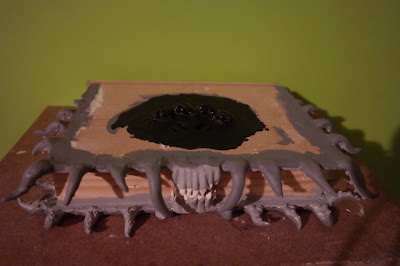There used to be a plastic memo board with a small pinboard and whiteboard. Although functional, it didn't really look great.
 |
| Finished piece |
There wasn't really a plan for this build, I took some measurements about the width and how big I wanted the shelves and the middle section to be (I wanted it as big as regular business cards and other passes/cards.
It's made from left-over pieces of wood (plywood/ MDF), a reused pin board and old curtain hooks. Basically the whole thing is made from actual scrap.
 |
| Grey primer |
When the woodwork was done I gave it a grey primer. On the left side I wanted a pin board, I used the cardboard one with the self adhesive velours from the previous memo board (I cut it to fit) and on the right side there would be a chalk board.
I had some left over brown from previous projects, this was going to be the base color. I liked to give it that "antique" look, but not the sanded kind (where you sand the edges, making the base color show through, with the risk of sanding too much and revealing the primer or wood)
I read somewhere you can use vaseline on the edges to prevent the top coating from sticking to the surface. I didn't have any laying around, I did however, have some hair straightener spray I never use. I took out the nozzle bit and applied some of the liquid with a paintbrush to the edges and a small dot/ strike every here and there.
When the white coat was applied and dry, I could easily scrape off the parts where I'd applied the hair straightener, with my nails (strong tape will also work).
To finish this project I painted the chalk board with special chalk board paint.
And I added some old curtain hooks to hang things on.
 |
| Finished and filled with things to show its functionality. |
 |
| Finished piece perspective view. |


























